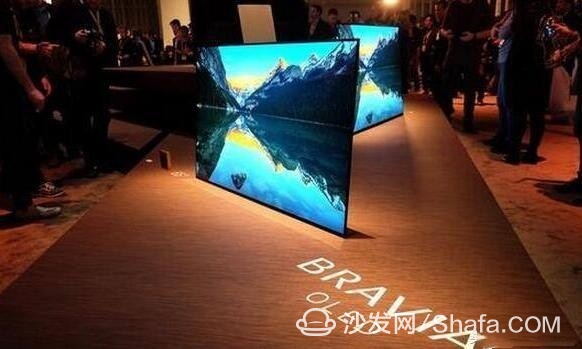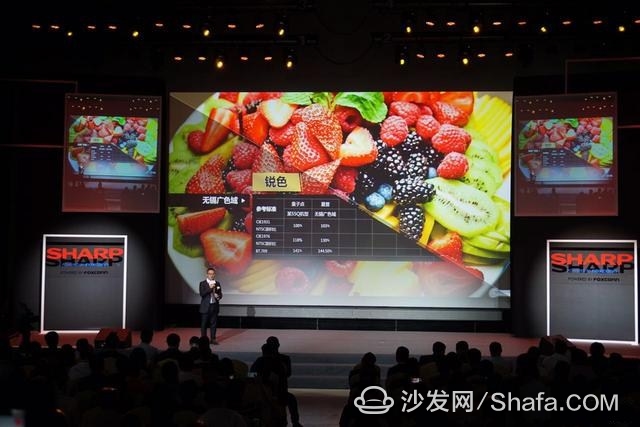There are two reasons for this situation: First, OLED has not been able to completely eliminate the problem of burn-in, technical defects are still more obvious; Second, LCD technology is still rising, such as Sharp recently launched 8K TV, the resolution Raise to a new height. From CCFLs to LEDs, from 4K to 8K, LCD technology continues to advance, and so on, OLEDs will have a hard time replacing LCDs.

8K, let LCD enter a new height
OLED: The root cause of promotion is technical defectsIn the four years since the beginning of 2013, news about OLED TVs has appeared from time to time. In 2017, it was the year of OLED news. At the beginning of the year, Sony introduced OLED TVs, followed by companies such as Philips and Panasonic, and even recently it was reported that Apple had to intervene. In the panel area, LGD said in its independent report that it will increase the production capacity of large-scale OLED panels in China through joint ventures, hoping that this move will promote the popularity of OLED TVs.
So anxious to deploy a near-monopoly technology in overseas markets, it is clear that LGD is not satisfied with the progress of OLED promotion. This is also true of the fact that during the initial years of OLED TV promotion, the process was rampant. The results were mostly downgraded, revised and slower than expected.
For example, before 2014, NPD DisplaySearch predicted that there will be an opportunity for more than one million OLED TV shipments in 2014; by 2016, the OLED TV market penetration rate is expected to exceed 3%. However, the result was counterproductive. DisplaySearch statistics show that in 2015, OLED TVs had 340,000 units shipped, and 2016 shipments of OLED TVs were 3% (according to 200 million units worldwide, 3% or 6 million units). There is a big difference, only 720,000 units. In the Chinese color TV market, the promotion of OLED TVs is not satisfactory. According to data from Zhong Yikang, the annual shipment of OLED TVs before 2016 is less than 50,000 units, which is bleak.
Of course, judging whether there is a market for a new technology should not be based solely on sales. Instead, it should first look at the technology to see if it is perfect and whether it has alternative conditions. Now, the problem with OLEDs is precisely in the technology itself. For example, LGBD has been criticized by everyone for its burn-in and low-yielding problems. Although LGD stated that it has been resolved, the results do not support the unilateral conclusions of this direct stakeholder.
There are pictures, including the Sony A1 series OLED TV, also pointed out in the product specification "If the entire image or part of the image remains static, the screen brightness will gradually reduce to prevent image retention," while claiming that "If the same image is repeatedly displayed or displayed For a long time, image sticking may occur. The panel refresh can be performed manually to reduce the image sticking phenomenon.†On the protection TV screen, “The OLED TV is prone to image sticking (burning) due to the characteristics of the materials usedâ€.

Sony also admitted not to be a team OLED
In fact, due to the inability to perfectly solve the burn-in phenomenon, Samsung took the initiative to suspend its plans to continue developing OLED TV panels before 2010. Because OLED can't solve the problem of burn screen, Samsung even launched the service of extending LCD panel burn screen warranty from one year to ten years in Europe last year. It obviously has the illusion of OLED "burning screen".
Technically speaking, the three kinds of red, blue, and green luminescent materials required by OLEDs have different aging lifetimes, resulting in different attenuation processes and color casts on the screen. Although the life problem has been solved by new materials, the high cost has become a problem that hinders the popularization of OLED TVs.
Because it is impossible to realize the cost reduction, the price of OLED TVs is still 2 times or even higher than that of LCD TVs of the same size, and it is far from the range of 1.2 times that the new technology replaces the old technology. Therefore, the above-mentioned OLED TVs are not accepted by consumers, and the initial poor sales results are also reasonable.
LCD: Continuous improvement is still the mainstream of the marketIf a technology has no room for improvement, it will be sooner or later replaced by new technologies. Just as CRT tubes have had limited room for improvement in the year, liquid crystals and plasmas can change the shape of the industry to drive industrial change. However, if a technology still has a lot of room for improvement, then it is difficult for a still-unstable new technology to attack the mature market technology, such as OLED LCD at this stage.
This four-and-five year OLED's unsatisfactory, both the reasons for their own technical defects, but also with the continuous improvement of liquid crystal technology is still continuous improvement, Moreover, many companies involved in the improvement of liquid crystal technology, Sharp, Samsung, Hisense, TCL, etc. Approved well-known color TV companies at home and abroad.
For example, Samsung, which temporarily suspended the development of OLED technology, has been promoting liquid crystal display technology for many years, and has bundled TCL to promote quantum dot television and achieved a good performance in the market. In these years, 4K LCD TVs, such as Hisense, have also challenged OLED TVs.
Of course, for OLEDs, the biggest pressure comes from Sharp, who is known as the father of LCD. On August 31st, Sharp launched a new slogan to build Sharp as "the father of 8K Ecology" and took the lead in the industry to launch consumer-grade AQUOS 8K TVs, raising the resolution of LCD TVs to a new level. .

8K New, 4x 4K Pixels
It is understood that in the picture quality, 8K TV not only has 8K resolution, 4 times the effective pixels of 4K, can faithfully feedback the image details, and at the same time refreshed at the frame rate of 12K at 120K, it can also ensure that each frame can display the most Details. The key point is that Sharp's 8K TV is equipped with new color technology, sharp color technology, and other post-operative images.
In the 4K era, content shortages were criticized by everyone, and Sharp made this 8K ecology to make up for the 8K shortcomings. It is understood that, in addition to the improvement of technical indicators, Sharp is currently seeking all aspects of the industry chain, in particular, Sharp planning work life, education life, entertainment life, family social life, safe life, healthy life, property purchase transaction life, environmental protection car The eight professionals in the 8K application scene collaborate. Thus formed a healthy ecosystem including many aspects including camera, scenery, image compression, editing, and transmission.

8K is NOW?
According to the latest news, current industry associations have organized companies including Sharp to establish 8K technical committees and actively promote the formulation of China's 8K standards.
The ever-increasing liquid crystal technology puts forward a higher “replacement†requirement for OLEDs. Sharp has also challenged the OLED camp with 8K resolution when OLED has not yet established a foothold in the 4K market. LCD technology has been continuously improved and OLEDs are constantly being poured. It is no wonder that OLEDs have not made major breakthroughs in recent years.
In fact, in the market, more companies are optimistic about the LCD, from the IHS DisplaySearch latest forecast data, 2017 LCD TV shipments were 222 million units, while OLED TV shipments were only 1.38 million units, and Even after 4 years to 2021, LCD TVs will also be far ahead, with shipments forecasted at 243 million units and OLED TV shipments at 6.6 million units.

DS forecast data
Under such circumstances, it is almost impossible for OLED to replace LCD in a short period of time. At least 3-5 years, LCD is still the mainstream of the color TV market at this stage.
Smart TV/box information can focus on smart TV information network sofa butler (http://), China's influential TV box and smart TV website, providing information, communication, TV boxes, smart TVs, smart TV software, etc. Answering questions.Household Electrical Appliances
gree , https://www.greegroups.com